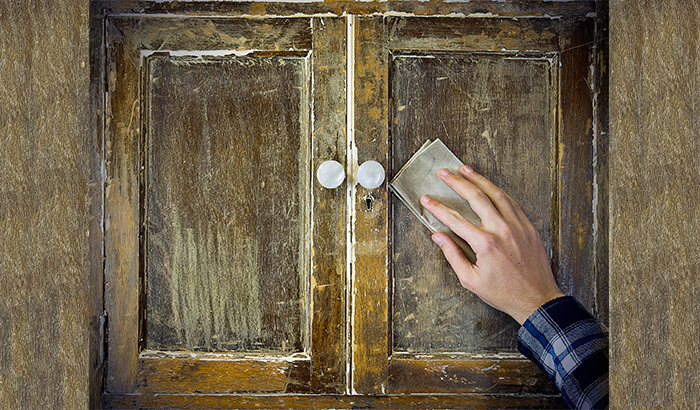Restoring old wood cabinets, particularly vintage or antique ones, can be a fun project, but it must be done with care and respect.
Many older cabinets were made with a high level of craftsmanship and artistic detail. Restoring these valuable pieces well means finding those unique features and allowing them to shine. The goal should not be to turn them into something modern and new, but to acknowledge their intrinsic beauty.
The thing about restoring old wood cabinets is that you may not know how excellent the piece is or what it will take to return it to its original glory until you start taking things apart and getting a closer look. This can be an exciting process of discovery. It can also be an emotional rollercoaster as you figure out what original components can be restored.
So while you may not yet know what to expect, here are a few things to keep in mind as you go.
1. Sometimes a Good Cleaning is All it Takes.
Older cabinets, especially ones in constant use, will pick up grime from smoke and dust in the air, splatter from cooking, and fingerprints. Simply removing these years of muck will do wonders.
For painted cabinets, dish soap and water will remove most of the grime. If you have tough grease built up, a mixture of vinegar and hot water, maybe with a few drops of lemon oil, should do the trick.
For stained cabinets, dish soap is still a good option, just don’t drown it in water. A damp microfiber cloth will work fine. For stubborn grease, mineral spirits are a great option.
2. Be Realistic about What Components can be Restored.
When restoring an antique cabinet, buffet, or credenza, it’s always nice if you can keep all the beautiful original parts – exactly the way your grandma had it – or at least someone’s grandma.
Sadly, some parts may not be salvageable. Water damage can warp or rot wood beyond useability. Cracked glass and chipped paint may hold some nostalgia value, but they detract from the original beauty of the piece. This isn’t the condition grandma kept it in. So take a deep breath and ask yourself if keeping your cabinet useable is worth sacrificing a little authenticity.
3. Straightening Warped Wood.
Just because wood has been warped doesn’t absolutely mean it’s a loss. You can often straighten out even very warped beams with some wood glue, screws, and clamps. Just make sure you leave them braced long enough for the reorienting to take full effect overnight.
4. Let The Woodgrain Show.
One of the most surprising things you can find out about an antique or vintage cabinet is that its current paint job wasn’t original – or even close to how it initially looked. Somewhere along the line, someone may have decided they wanted to go with a blue color scheme and went on a half-cocked painting spree.
Restoring a cabinet to its original woodgrain can bring out some beautiful patterns, especially if it’s made from a nice hardwood like red oak or black walnut. Matching that with the right stain can be better than any coat of paint.
5. Avoid Using Harsh Chemicals.
Generally, you want to avoid putting caustic chemicals on your wood, especially older wood. And most of the time there’s no reason to. Here are a few examples of things you should and shouldn’t use:
- For cleaning, avoid using all-purpose cleaners. Dish soap works fine.
- To kill mold – never use bleach on a porous surface. Vinegar, hydrogen peroxide, and tea tree oil work great.
- If you need to remove paint or urethane, sometimes a sander and brillo pad will go pretty far. If you have to use a chemical stripper, you don’t need to use a super corrosive one that burns your eyes and lungs. There are less caustic, more environmentally friendly options that work very well, like Soy Gel.
6. Apply a Primer Before You Paint.
This is good advice for any cabinet restoration or any painting project period. But it’s shocking how often people skip this step and then complain that their finished product isn’t what they were hoping for. Primer acts as a sealer for porous material like wood. It improves adhesion so the paint lasts longer and helps create a nice uniformity in the color.
7. Be Delicate.
Restoring old wood cabinets is a very delicate process. Often the joints have had some wear so they’re more likely to crack under too much pressure. Most antiques were made during a time when things weren’t built as bulky as they are now either. Thinner and lighter also mean more fragile, so use care.
8. Reinforce Wobbly Drawers.
Again, many years of use can put a lot of stress on wooden joints. This could be true for any joint, but you tend to see it more with drawers because they are the parts that are most often handled. You can remedy this by adding a support brace or two along the inside corners of the drawer. Putting a couple of drops of wood glue in each corner doesn’t hurt either.
9. Replace Screws and Polishing Hardware.
This relatively small thing can go a long way to restore function and take the years back. You may have some gorgeous hinges hiding under a layer of tarnish or rust. As you’re prepping your cabinet, remove all the knobs, handles, locks, hinges, etc.
For brass and copper hardware, mix equal parts of vinegar, flour, and salt. Cover each metal component with the paste and let it soak for a few minutes. After cleaning it off, use a soft cloth to buff each piece into a nice shine. For zinc alloys or plated brass and other metals, a different solution may work better.
Come to Allen Brothers Cabinet Painting for Antique Cabinet Restoration
If you decide you’d like some help prepping and repainting your vintage or antique cabinets, we’re ready and willing to help. We can come to you in Sandy, Draper, South Jordan, West Jordan, Salt Lake City, and other nearby cities and towns.
We are experts at restoring old wood cabinets to their original beauty. Whether free-standing or wall-mounted, we’ll come in, get the job done as efficiently as possible, and then leave you with a breathtaking new look and no mess. Contact us for a free estimate today.


